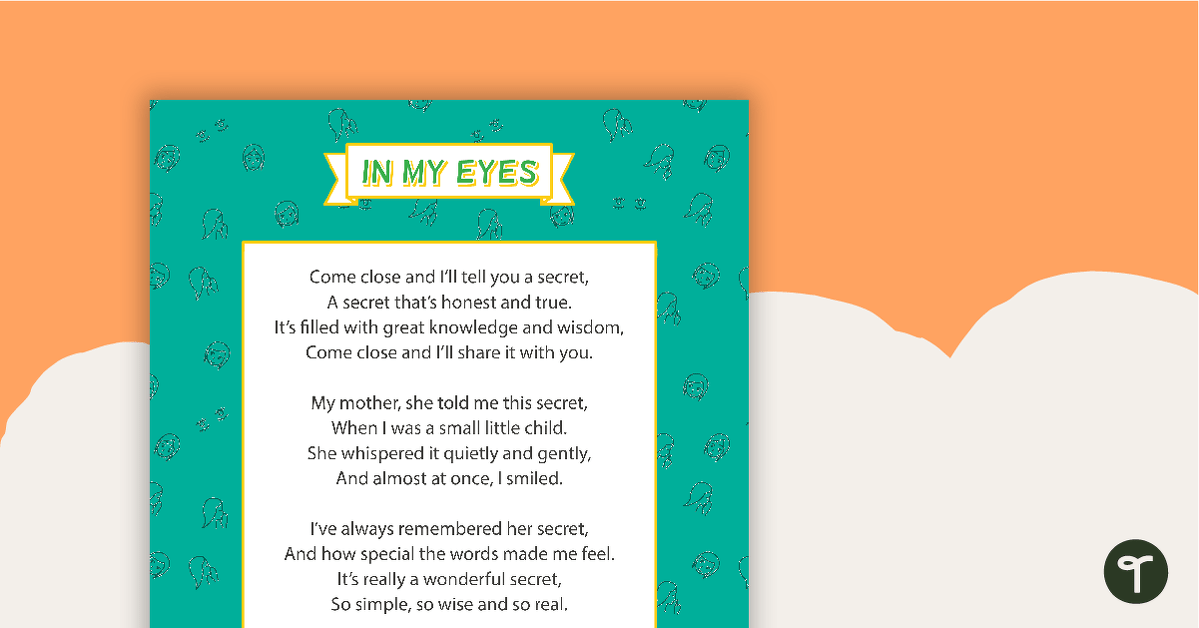A comprehension activity using poetry.
Use this comprehension activity when teaching students how to interpret poetry. This task includes a poem about a secret, questions and suggested answers.
Updated: 07 Jun 2018
A comprehension activity using poetry.
Non-Editable: PDF
Pages: 4 Pages
Years: 4 - 6
Use comprehension strategies, such as visualising, predicting, connecting, summarising, monitoring and questioning, to expand topic knowledge and ideas, and begin to evaluate texts to build literal and inferred meanings <ul> <li>making connections between information in print, images and sound</li> <li>reading or listening for key topic-specific vocabulary words to build understanding</li> <li>reading or listening to interpret the main idea and supporting ideas</li> <li>identifying evidence and reasoning used by authors to support points or arguments</li> <li>applying self-monitoring strategies such as re-reading, pausing and questioning, and self-correction strategies such as confirming and cross-checking</li> <li>connecting the use of colours, images, symbols and patterns in texts by Aboriginal and Torres Strait Islander authors and illustrators</li> <li>evaluating an author’s use of evidence to support arguments</li> </ul>
Read different types of increasingly complex texts, integrating phonic, semantic and grammatical knowledge to read accurately and fluently for meaning, re-reading and self-correcting when needed <ul> <li>using subject and technical vocabulary and concept knowledge to navigate less familiar texts</li> <li>skimming and scanning to check the pertinence of particular information to their topic and task</li> <li>using signposting features such as headings and subheadings, and home pages and subpages to read texts</li> </ul>
Use comprehension strategies, such as visualising, predicting, connecting, summarising, monitoring and questioning, and connect and compare ideas from a variety of sources to build literal and inferred meanings <ul> <li>making connections between the text and their own experiences or other texts</li> <li>making connections between information in print and images</li> <li>using prior knowledge and textual information to make inferences</li> <li>asking and answering questions</li> <li>using graphic organisers to visualise connections, categories and hierarchies of information</li> <li>summarising a text or part of a text</li> </ul>
Builds knowledge and use of Tier 1, Tier 2 and Tier 3 vocabulary through interacting, wide reading and writing, and by defining and analysing words
Fluently reads and comprehends texts for wide purposes, analysing text structures and language, and by monitoring comprehension
Plans, creates and revises written texts for multiple purposes and audiences through a selection of text features, sentence-level grammar, punctuation and word-level language
Analyses representations of ideas in literature through genre and theme that reflect perspective and context, argument and authority, and adapts these representations when creating texts
Use comprehension strategies to build literal and inferred meaning to expand content knowledge, integrating and linking ideas and analysing and evaluating textsElaborationsmaking connections between the text and studentsâ own experience and oth...
Navigate and read texts for specific purposes applying appropriate text processing strategies, for example predicting and confirming, monitoring meaning, skimming and scanningElaborationsbringing subject and technical vocabulary and concept knowledge...
Use comprehension strategies to interpret and analyse information and ideas, comparing content from a variety of textual sources including media and digital textsElaborationsmaking connections between the text and studentsâ own experience or oth...
Use comprehension strategies such as visualising, predicting, connecting, summarising, monitoring and questioning to build literal and inferred meaning, to expand topic knowledge and ideas, and evaluate texts
Navigate and read texts for specific purposes, monitoring meaning using strategies such as skimming, scanning and confirming
Use comprehension strategies such as visualising, predicting, connecting, summarising, monitoring and questioning to build literal and inferred meaning, and to connect and compare content from a variety of sources

A comprehension activity using poetry.
Use this comprehension activity when teaching students how to interpret poetry. This task includes a poem about a secret, questions and suggested answers.
Use comprehension strategies, such as visualising, predicting, connecting, summarising, monitoring and questioning, to expand topic knowledge and ideas, and begin to evaluate texts to build literal and inferred meanings <ul> <li>making connections between information in print, images and sound</li> <li>reading or listening for key topic-specific vocabulary words to build understanding</li> <li>reading or listening to interpret the main idea and supporting ideas</li> <li>identifying evidence and reasoning used by authors to support points or arguments</li> <li>applying self-monitoring strategies such as re-reading, pausing and questioning, and self-correction strategies such as confirming and cross-checking</li> <li>connecting the use of colours, images, symbols and patterns in texts by Aboriginal and Torres Strait Islander authors and illustrators</li> <li>evaluating an author’s use of evidence to support arguments</li> </ul>
Read different types of increasingly complex texts, integrating phonic, semantic and grammatical knowledge to read accurately and fluently for meaning, re-reading and self-correcting when needed <ul> <li>using subject and technical vocabulary and concept knowledge to navigate less familiar texts</li> <li>skimming and scanning to check the pertinence of particular information to their topic and task</li> <li>using signposting features such as headings and subheadings, and home pages and subpages to read texts</li> </ul>
Use comprehension strategies, such as visualising, predicting, connecting, summarising, monitoring and questioning, and connect and compare ideas from a variety of sources to build literal and inferred meanings <ul> <li>making connections between the text and their own experiences or other texts</li> <li>making connections between information in print and images</li> <li>using prior knowledge and textual information to make inferences</li> <li>asking and answering questions</li> <li>using graphic organisers to visualise connections, categories and hierarchies of information</li> <li>summarising a text or part of a text</li> </ul>
Builds knowledge and use of Tier 1, Tier 2 and Tier 3 vocabulary through interacting, wide reading and writing, and by defining and analysing words
Fluently reads and comprehends texts for wide purposes, analysing text structures and language, and by monitoring comprehension
Plans, creates and revises written texts for multiple purposes and audiences through a selection of text features, sentence-level grammar, punctuation and word-level language
Analyses representations of ideas in literature through genre and theme that reflect perspective and context, argument and authority, and adapts these representations when creating texts
Use comprehension strategies to build literal and inferred meaning to expand content knowledge, integrating and linking ideas and analysing and evaluating textsElaborationsmaking connections between the text and studentsâ own experience and oth...
Navigate and read texts for specific purposes applying appropriate text processing strategies, for example predicting and confirming, monitoring meaning, skimming and scanningElaborationsbringing subject and technical vocabulary and concept knowledge...
Use comprehension strategies to interpret and analyse information and ideas, comparing content from a variety of textual sources including media and digital textsElaborationsmaking connections between the text and studentsâ own experience or oth...
Use comprehension strategies such as visualising, predicting, connecting, summarising, monitoring and questioning to build literal and inferred meaning, to expand topic knowledge and ideas, and evaluate texts
Navigate and read texts for specific purposes, monitoring meaning using strategies such as skimming, scanning and confirming
Use comprehension strategies such as visualising, predicting, connecting, summarising, monitoring and questioning to build literal and inferred meaning, and to connect and compare content from a variety of sources

We create premium quality, downloadable teaching resources for primary/elementary school teachers that make classrooms buzz!
Would you like something changed or customised on this resource? While our team makes every effort to complete change suggestions, we can't guarantee that every change will be completed.
Did you spot an error on this resource? Please let us know and we will fix it shortly.
Are you having trouble downloading or viewing this resource? Please try the following steps:
If you are still having difficulty, please visit the Teach Starter Help Desk or contact us .

A fun game for students to play in small groups to consolidate their understanding of adjectives.

A fun game for students to play in small groups to consolidate their understanding of adverbs.

A set of 12 Queensland Cursive entry and exit shuttles to join together to make a handwriting spaceship.

A fun game for students to play in small groups to consolidate their understanding of verbs.

A set of 12 Queensland Cursive entry and exit shuttles to join together to make a handwriting spaceship.

A set of 12 Queensland Cursive entry and exit shuttles to join together to make a handwriting spaceship.

Lower Grade Desk Plates with the alphabet, number line and student's name on them.

A sheet of letters to use when making CVC words.

Use this set of Year 1 editing passages to help your students demonstrate their spelling, punctuation and grammar knowledge.

A NAPLAN-style rubric designed to help teachers to assess student's poetry.
0 Comments
Write a review to help other teachers and parents like yourself. If you'd like to request a change to this resource, or report an error, select the corresponding tab above.